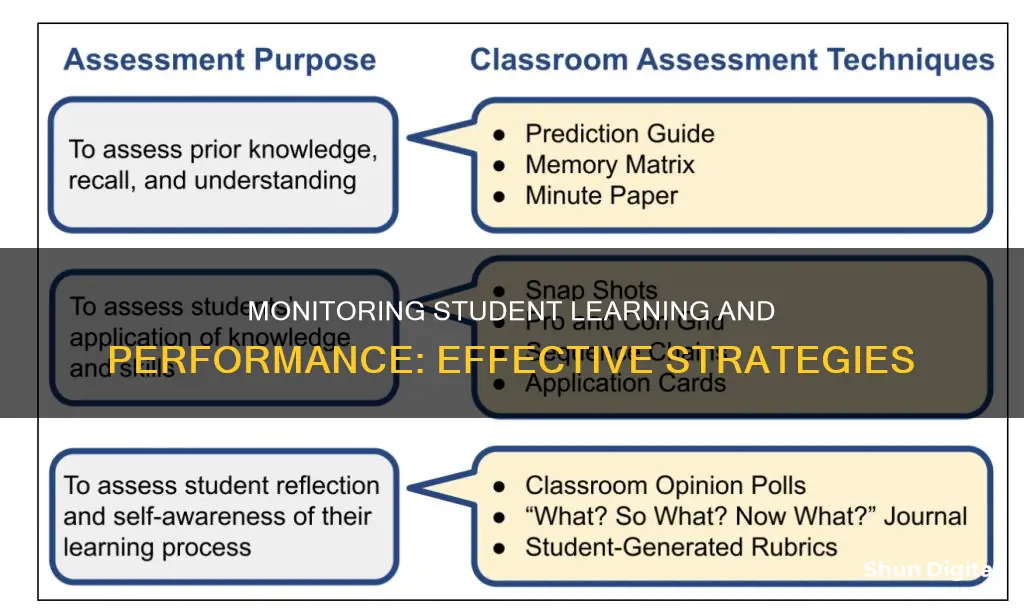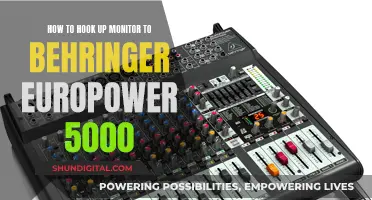
Monitoring student learning and performance is an essential aspect of education, and it involves more than just evaluating students. Regular assessments, both formal and informal, provide valuable data on student progress and achievements, allowing teachers to reflect on their instructional strategies and make necessary adjustments. This process benefits both students and teachers by encouraging growth, enhancing differentiation, and ensuring that no student is left behind. With the advancement of technology, educational institutions are now exploring artificial intelligence and machine learning algorithms as tools to support the systematic monitoring of student performance and to identify students who may need additional support.
| Characteristics | Values |
|---|---|
| Purpose | Ensure achievement for every student |
| Data Collection | Formal and informal assessments, student samples of work, homework |
| Data Utilisation | Identify students at risk, evaluate teaching effectiveness, inform instructional decisions |
| Benefits | Collect useful data, improve teacher instruction, encourage student growth, enhance differentiation opportunities |
| Techniques | AI and machine learning algorithms, interactive multiple choice, eye contact and proximity, exit slips/tickets |
What You'll Learn

Collecting data through regular assessments and work samples
Formative assessments, or low-stakes assessments, are a valuable tool for teachers to gather information on student progress and adjust their teaching methods accordingly. These can include exit tickets, brief quizzes, thumbs up/down, and fill-in-the-blank exercises. For example, a teacher might give students a sentence with a missing keyword and ask them to fill in the blank, or use a traffic light system where students display green for understanding, yellow for confusion, and red for being lost. This immediate feedback allows teachers to adapt their lessons and provide additional support or challenges as needed.
Another method is through summative assessments, which are more formal and are used to measure student learning at the end of a lesson or unit. These can include projects, essays, and exams. These assessments provide an opportunity to evaluate the effectiveness of teaching methods and identify areas where students may need additional support or review.
Work samples are also a valuable source of data. Teachers can collect and review student work, such as papers, design projects, or quiz results, to assess their understanding and identify areas for improvement. This helps teachers track individual student progress and provide targeted feedback.
Observations are another important aspect of data collection. By walking around the classroom and sitting with student groups, teachers can gather data on how well students are understanding the content, interacting with peers, and engaging in learning activities. This allows teachers to make adjustments to the pacing of lessons and provide additional support to struggling students.
By combining these methods of data collection, teachers can gain a comprehensive understanding of student learning and performance. This data-informed approach enables teachers to adapt their teaching methods, provide targeted feedback, and ultimately improve student outcomes.
Identify Monitor Port Types: A Quick Guide to Checking
You may want to see also

Evaluating teacher instruction and adjusting strategies
Regular Student Progress Monitoring:
Teachers can regularly assess student progress through formal and informal evaluations. This includes collecting student work samples and performance data to identify areas where adjustments might be needed. Monitoring student progress allows teachers to reflect on their instructional strategies and make necessary changes to benefit the entire class or individual students.
Feedback and Adjustments:
Teachers can solicit midterm student feedback to evaluate the effectiveness of their instructional methods. This feedback can be used to adjust teaching strategies and improve overall instruction. It is essential to create a safe and supportive environment for students to provide honest feedback.
Instructional Delivery:
Teachers should focus on the quality, amount, and level of classroom instruction. This includes ensuring that lessons are delivered at an appropriate pace and that the content is accessible to all students. If most students are struggling, teachers should reevaluate their teaching methods and consider re-teaching the lesson using different approaches.
Grading and Assessment:
Grading and assessing student learning is a crucial aspect of evaluating teacher instruction. Teachers should use appropriate levels of assignments and exams, applying consistent grading standards. Regular assessments help teachers identify areas where students are excelling or falling behind, allowing them to adjust their strategies accordingly.
Course Planning:
Teachers should continuously engage in course planning and revision. This includes developing new courses and updating existing course materials to ensure they are relevant, engaging, and aligned with the learning objectives. Teachers can also provide study guides, worksheets, lecture outlines, and film scripts to support student learning.
Differentiated Instruction:
Teachers should be prepared to adapt their teaching strategies to accommodate diverse student needs. This includes modifying instruction for special needs students and providing alternative methods for students with different learning styles. For example, if a student struggles with reading written material, the teacher might provide highlighted text, allow a peer to read aloud, or suggest a film adaptation.
By implementing these evaluation strategies and adjusting their instructional approaches, teachers can ensure that their methods are effective and aligned with the needs of their students. Regular monitoring of student progress and teacher instruction is essential to create a dynamic and responsive learning environment.
Should You Remove the Plastic Film on Your Monitor?
You may want to see also

Encouraging student growth through feedback
The importance of feedback
Feedback is an essential part of the learning process. It provides students with clear guidance, helping them to understand their strengths and weaknesses, and fostering a positive academic environment. When students receive meaningful feedback, they are more likely to stay motivated and engaged in their studies.
Best practices for giving feedback
- Specificity: Avoid vague statements such as "great job" or "needs improvement". Instead, provide precise information about what the student did well and what could be improved.
- Timeliness: Feedback is most effective when given immediately, allowing students to connect it with their recent work.
- Goal-orientation: Frame feedback around specific goals or achievements that students are working towards. This helps students understand how the feedback will help them progress.
- Careful presentation: The way feedback is presented can impact how it is received. Avoid overly negative or corrective language, and be mindful of how often and in what context feedback is given, so as not to make students feel too closely monitored or that feedback is an attempt to control them.
- Involving learners: Encourage self-assessment and reflection by providing students with access to performance data. This helps students develop an awareness of their learning and take ownership of their progress.
Practical techniques for effective feedback
- Be specific and goal-oriented: Provide comments that guide students towards clear goals. For example, instead of saying "needs more detail", suggest adding specific examples to support the main idea.
- Focus on the process, not just the product: Acknowledge the student's effort and strategy, and provide feedback on their approach to tasks, not just the results.
- Feedforward instead of feedback: Rather than focusing on what went wrong, give guidance that students can apply in the future.
- Make feedback a two-way conversation: Encourage students to ask questions and reflect on the feedback. This helps them process and respond to it, and creates a dialogue that deepens their understanding.
- Encourage reflection and self-assessment: Suggest that students keep a "feedback journal" to record feedback and reflect on their progress over time.
- Normalise mistakes: Help students view mistakes as learning opportunities, not failures. Reinforce that mistakes are normal and part of the learning journey to build resilience and confidence.
- Emphasise effort and strategy: Praise students for their effort, strategies, and persistence, not just their successes.
Benefits of monitoring student progress
Regular monitoring of student progress provides teachers with valuable data to track individual student development and achievement. It also allows teachers to reflect on their teaching methods and adjust their instructional strategies to better meet the needs of their students. Monitoring student progress is a key component of effective teaching and has a significant positive impact on student success.
University WiFi: Staff Privacy and Monitoring Concerns
You may want to see also

Identifying students at risk with early intervention
Student learning and performance can be monitored in a variety of ways, including formal and informal assessments, data collection, and observations. This information can then be used to identify students who may be at risk and provide early intervention to support their learning and well-being. Here are some strategies for identifying students at risk and providing early intervention:
- Collect and analyse data: Collecting data on student performance and progress can help identify students who may be falling behind or struggling in specific areas. This data can include grades, attendance records, and results from formal and informal assessments. By analysing this data, teachers can identify students who may be at risk of not meeting their learning goals and put early intervention strategies in place.
- Observe student behaviour: Teachers should pay attention to students' behaviours, both in and out of the classroom. Signs such as absenteeism, disruptive behaviour, or emotional distress may indicate that a student is at risk. By noticing these behaviours early on, teachers can intervene and provide support to help address any underlying issues.
- Use a systematic approach: A systematic approach to identifying at-risk students involves defining the purpose of data collection, choosing relevant indicators, and involving a team of practitioners in the data collection and analysis process. This ensures that distress signals are not overlooked and that students receive the necessary support in a timely manner.
- Consider risk factors: Risk factors such as adverse childhood experiences, gender, ethnicity, special educational needs, and socio-economic status can increase the likelihood of a student experiencing mental health problems or struggling academically. By understanding these risk factors, teachers can identify students who may be at risk and provide appropriate interventions or referrals to support services.
- Monitor student progress regularly: Regular monitoring of student progress allows teachers to track individual students' performance and growth over time. This helps identify students who may be falling behind or struggling in specific areas and provides an opportunity to adjust teaching strategies or provide additional support as needed.
- Encourage student growth: Providing students with feedback on their progress encourages them to take ownership of their learning and become more aware of their academic performance. This can help students stay motivated and identify areas where they may need additional support.
- Build positive relationships: Building positive relationships with students can help create a safe and supportive learning environment. When students feel comfortable and trusted by their teachers, they are more likely to seek help when needed and be receptive to early intervention efforts.
- Provide a range of support options: Early intervention can take many forms, such as additional teaching support, mentoring, counselling, or referrals to external support services. It is important to offer a range of options to meet the diverse needs of students and ensure that they receive the most appropriate form of assistance.
- Involve practitioners in data analysis and decision-making: Practitioners, including teachers, counsellors, and other professionals, should be involved in analysing data and deciding on appropriate interventions for at-risk students. Their direct and regular contact with students provides valuable insights into students' well-being and can help tailor interventions to individual needs.
The Christian Science Monitor: Where to Buy Print Copies
You may want to see also

Utilising AI and machine learning to monitor and support
AI and machine learning can be used to monitor and support student learning and performance in several ways.
Profiling and Prediction
AI can be used to profile students and make predictions about their performance. This can be used to identify students who are at risk of failing and offer them additional support. For example, AI can be used to predict the likelihood of a student dropping out of a course. This information can then be used by instructors to offer additional support to struggling students.
Assessment and evaluation
AI can be used to automate the assessment and evaluation of student work. This includes automated grading and feedback as well as evaluation of student understanding, engagement, and academic integrity. Automated grading systems can reduce the workload for teachers and provide students with more frequent feedback.
Intelligent tutoring systems
AI can be used to develop intelligent tutoring systems (ITS) that can simulate one-on-one personal tutoring. These systems can make decisions about the learning path of an individual student and provide them with tailored content, feedback, and support. ITS can be particularly useful in large-scale distance education programs where human one-on-one tutoring is not feasible.
Adaptive systems and personalisation
AI can be used to develop adaptive systems that personalise the learning experience for each student. These systems can use student data to recommend or provide personalised content, support teachers in learning and teaching design, and monitor and guide students.
Understanding EDP LCD and Monitor Technology
You may want to see also
Frequently asked questions
Monitoring student learning and performance is beneficial for both teachers and students. Teachers can use the data to identify students who are at risk academically and adjust their teaching methods to better meet the needs of these students. It also allows teachers to evaluate the effectiveness of their teaching methods and make more informed decisions about instruction. Monitoring student progress also encourages student growth by helping them take greater personal responsibility for their learning and become more aware of their academic performance.
There are several methods that can be used to monitor student learning and performance. These include formal and informal assessments, such as tests, quizzes, and assignments, as well as observing students' expressions, postures, and behaviour during lessons. Collecting and analysing student data is also important, including grades, attendance records, and interaction with online social forums.
Monitoring student learning and performance can help teachers evaluate the effectiveness of their teaching methods and make adjustments as needed. For example, if most students are struggling to understand a concept, the teacher may need to re-evaluate their delivery method or instructional strategies. Monitoring can also help teachers identify students who need additional support or instruction and provide intervention when required.







